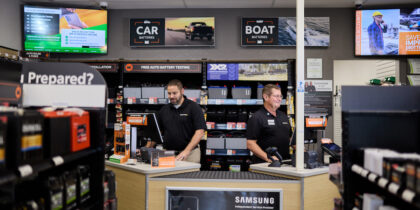In a saturated marketplace, retailers that intimately engage customers will likely gain their loyalty. Digital signage allows companies to more personally engage with customers through targeted messaging and integrated social media, two factors that resonate with shoppers and drive long-term relationships. No longer used for static messages, digital signs have evolved into interactive appliances that use full-motion video and touch to emulate interactive digital experiences, promoting product browsing and, in some cases, enabling online shopping. They are the perfect tools for attracting new customers, enriching the in-store experience and driving sales.
Where Digital Signage Has an Impact
While early versions of digital signs were often written off as expensive in-store posters, consumers’ love affair with digital solutions is shifting the tide. Digital signage has proven its worth as sales messaging becomes more dynamic, engaging and targeted. Retailers can customize what they display based on subsets of customers, creating an individualized experience. This leads to increased customer satisfaction. When you consider consumers’ love affair with digital solutions, it is not surprising that retailer interest is clearly shifting. One way to garner this shopper attention is to focus more on social media.
According to the Pew Research Center’s “Social Media Update 2014,” 74 percent of online consumers use social media. While retailers use their social networks as a channel to build customer engagement, the time is ripe to bring these messages in house. Specifically, retailers can leverage their existing online and social media content on in-store digital signage as a way to generate buzz and even drive new social media likes and followers while people shop.
To take this one step further and make social signage truly engaging, retailers may consider incorporating in-store Pintrest access via digital touchscreens. Pinterest, a social media bookmarking site of sorts, groups “pins,” or content preferences, together by topic in a user’s profile. Each board mimics a real-life pinboard or scrapbook. To create even more engagement, the social media site recently announced that it now enables users to buy their pin preferences. Called “buyable pins,” sellers, which include retailers such as Cole Haan, Ethan Allen, Kate Spade and Macy’s, can now add a purchase button on items they post to the site. Interactive digital signage that enabled consumers to access their Pintrest profile page is just one creative example of where social media could drive engagement and more revenue.
While the above are large brands, brick-and-mortar businesses of all sizes are primed to gain immediate benefit from digital signage. With the average retailer’s rent in New York hovering at $3,300 per square foot per year, according to a 2013 study by CBRE Research, brands can use these multipurpose tools to make the most of their limited floor space and cut down on clutter from static media. Digital displays also allow businesses to reduce on-site inventory, displaying goods in high detail without requiring the physical items to be present.
Additionally, by using the sleek screens to highlight information, drive promotions and entertain shoppers, digital signs improve store decor, solidifying customer brand perceptions and relationships. Smart displays can introduce a social element that engages directly with shoppers through their favorite channels. For example, a browsing customer could see a Twitter feed tuned into hashtags relevant to the store’s specific products. Alternatively, the store could have its own specific feed that aggregates shoppers’ tweets, allowing them to communicate with associates and other patrons alike. Digital signs’ potential for engagement is virtually endless, and when comparing the cost and time it takes to create printed media, businesses can easily see the positive return on investment.
Displaying the Right Messages at the Right Time
Perhaps the biggest benefit is the ability to connect with shoppers at the ideal time. Success is based on strategic scheduling of digital content. More specifically, retailers must adjust and deliver targeted messages based on specific times, days, traffic levels, sales trends, customer segments and promotions. This allows businesses to reach customers when they’re most likely to make purchase decisions.
By working with Aerva, Samsung is helping retailers achieve this exact goal. Aerva’s user-friendly, Web-based software platform enables users to manage and schedule content on networked displays. In January of 2014, Samsung and Aerva proved the value of their technology during the annual National Retail Federation Big Show in New York City. They used digital signs and the content platform to stream live tweets about the convention on large-format displays. Attendees also submitted their own pictures using the hashtag #AervaNYC or via email, which Aerva’s Moderation Engine curated and broadcasted on a digital billboard in Times Square.
5 Ways to Drive Small Business Sales with Smart Signage from Samsung Business USA
In such a saturated retail marketplace, retailers that intimately engage customers will likely gain their loyalty. Put your business on display using Samsung’s Smart Signage.







